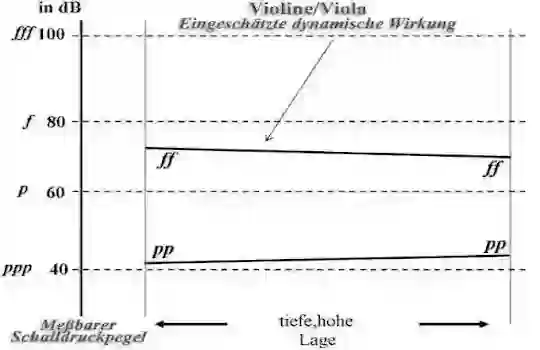Sound character of the viola - Philipp Dangas
Register table of the viola
The tonal properties of the strings of string instruments are of the utmost importance for instrumentation and should be carefully studied in order to make the right choice in instrumentation. The violin scale can be described as homogeneous . But every single string has its own special characteristics.
As part of the „symphonic world music“
The viola is a main instrument of the string section. The main task of the viola is to create the overall sound. In addition, the violas can be divided in order to entrust them with different tasks.
[Composer: Shostakovich, Dmitri]
Download Size: 206 Kilobytes
Table summary of the sound character of the viola
The following table shows the timbres of the viola briefly described. And the sound character it creates.
Dynamic effect of the violin/viola
Sheet music for the dynamic table of the violin/violaThe following representation of the dynamic table gives the degrees of strength of musical dynamics. In addition to the sound pressure scale, measured in decibels [dB], the degrees of intensity of musical dynamics are indicated on the left of this sound pressure scale, which may be understood as "objective" degrees.
A diagram is also drawn in, to the right of the dB scale. It shows the estimated dynamic effect over the entire tonal range of the instrument. The dynamic effect (volume) as judged (perceived) by the listener.
Now an example: In the low tonal range of the Trumpet it contains a dynamic extension between pianissimo [pp] (46 Dezibel [dB]) and fortissimo [pp] (82 Dezibel [dB]) = 36 Dezibel [dB]. The dynamic extension in the higher tonal ranges contains 8 Dezibel [dB]. The minimum values can differ less or more than the maximum.
Understandably, these values vary from instrument to instrument. The mentioned "objective" levels of intensity piano pianissimo [ppp]= 40 decibels [dB], p=60 decibels [dB] etc. enable the composer to predict the dynamic effects of different instruments that are sounding simultaneously.
Table summary of the dynamic range of the violin/viola
The following table shows the achievable dynamic range of the violin shown. The span is the difference between the fortissimo and the pianissimo in the same pitch.

The register table of a viola in large scale
- A String
- Pretty piercing.
- D String
- Weak and uncharacteristic, mainly used for accompanying characters.
- G String
- Fairly weak, not as strong as the violin's G string, also used for accompaniment.
- C String
- Very characteristic, dark and rough.

The dynamic chart of a violin/viola
Internal search function
| Name | Value | Delete |
|---|